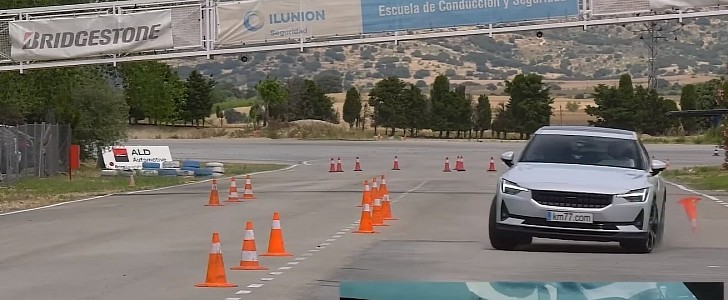The Polestar 2 was put through the famous moose test at km77.com, showing good manners and safety during sudden avoidance maneuvers. But it wasn’t all flying colors, as the Swedish EV can still improve its performance.
Electric vehicles have a low center of gravity thanks to a floor-mounted battery pack, which should be enough to make them very stable while cornering. But they are also heavier, so the theory does not always stand the real-life test. We know that from the many EVs tested by the guys at km77.com, and the BMW i4 is one prime example. Is the Polestar 2 any better at avoiding obstacles? The answer is complicated.
If we count the fact that the electric sedan remained stable throughout the test and did not exhibit violent oversteering like the BMW i4 did, it was better. But its highest successful speed, for which the test ended without a cone carnage, was only 1 kph (0.62 mph) higher – 74 kph (46 mph) vs. 73 kph (45 mph). For comparison, the Tesla Model 3 and Model Y completed the test at a much higher speed (83 kph/52 mph).
According to km77.com, the Polestar 2 used for the test was equipped with the Performance package. This comes with upgrades such as Öhlins shock absorbers with manual adjustment, 20-inch forged wheels with specific tires, and an upgraded brake system manufactured by Brembo. The regular version of the car would’ve likely performed even worse.
The testers noted that the Polestar 2 showed the best maneuverability with the regenerative braking activated at the lowest level. This put enough weight on the front wheels to limit the understeer. The car performed much better in the slalom test, showing decent grip and limited body roll. The 22.8-second time was the best among its peers, although the top does not include any Tesla EVs, whose slalom test wasn’t time-counted.
If we count the fact that the electric sedan remained stable throughout the test and did not exhibit violent oversteering like the BMW i4 did, it was better. But its highest successful speed, for which the test ended without a cone carnage, was only 1 kph (0.62 mph) higher – 74 kph (46 mph) vs. 73 kph (45 mph). For comparison, the Tesla Model 3 and Model Y completed the test at a much higher speed (83 kph/52 mph).
According to km77.com, the Polestar 2 used for the test was equipped with the Performance package. This comes with upgrades such as Öhlins shock absorbers with manual adjustment, 20-inch forged wheels with specific tires, and an upgraded brake system manufactured by Brembo. The regular version of the car would’ve likely performed even worse.
The testers noted that the Polestar 2 showed the best maneuverability with the regenerative braking activated at the lowest level. This put enough weight on the front wheels to limit the understeer. The car performed much better in the slalom test, showing decent grip and limited body roll. The 22.8-second time was the best among its peers, although the top does not include any Tesla EVs, whose slalom test wasn’t time-counted.









